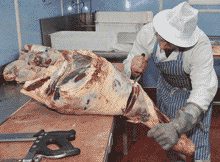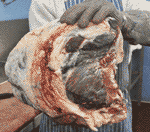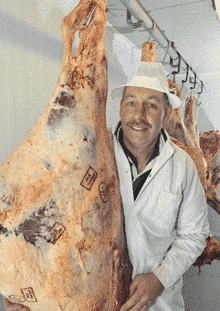Food Chain: Getting the most from native-bred beef

An increasing number of beef farmers are turning to native breeds, but maximising their eating quality is a fine art, as Jeremy Hunt discovers.
 |
|---|
| Butcher Peter Fortune says native breeds need different standards of butchery. They also need more time to hang and mature. |
Protecting the eating quality of native-bred beef between field and fridge is just as important as the time and effort taken to rear it. For native breeds that can be close to 30 months on many farms.
Assuming that any slaughterer or butcher picked at random can undertake the final and critical stage of preparing the beef for consumption is naive to say the least. It is nevertheless a hurdle that more than a few have stumbled over as they venture into marketing such high-quality beef carcasses.
Peter Fortune works for organic farmer Adrian Procter at Far Cappleside, Rathmell, near Settle, North Yorkshire, and is in no doubt that carcasses capable of earning substantial price premiums over conventional beef demand high standards of butchery skills.
All the finished beef cattle produced at Far Cappleside are slaughtered near Preston, less than an hour away, and returned to the farm for hanging within 72 hours. The quartered carcasses are hung traditionally for at least three weeks and possibly up to five weeks.
“The extra fat cover on native breeds ensures the flesh doesn’t dry out and doesn’t get ‘sticky’ while it’s maturing – it’s the fat that keeps the flesh air-tight. But allowing enough time for the meat to mature is absolutely essential,” says Mr Fortune, who is adamant that native-bred beef cannot be treated in the same way as the conventional beef that provides volume supplies for the supermarket trade and which can be on sale within days of being killed.
CASE STUDY: Far Cappleside
Adrian Procter (pictured) has been producing organic beef, lamb and pork for four years from his farm at Far Cappleside, Rathmell, near Settle, where he runs about 45 native-bred suckler cows including cross-bred Beef Shorthorn, Hereford, Aberdeen Angus and Red Poll. A purpose-built on-farm butchery and cold store handles the finished cattle bound for direct sales, with carcass weights ranging from 250-300kg deadweight. “It’s critical that the quality of the cattle we’re producing isn’t lost at the butchery stage,” he says. “While the flesh is on the bone it won’t take any harm and will improve the eating quality and that’s why we can hang beef for up to six weeks. “It’s important how you handle this meat from the day it’s slaughtered and who butchers and cuts the carcass. Nothing should be left to chance. There’s no income until the beef is sold to the customer – and if you want that customer to come back you’ve got to make sure the product is absolutely right.” Mr Procter is now supplying organic beef to some of the top restaurants in the region, as well as a leading local butcher Roy Porter at Chatburn near Clitheroe. All beef is vacuum packed and labelled and carries the regulatory information and use-by date. |
|---|
A premium product
As he cuts an almost 30-month-old Beef Shorthorn x Aberdeen Angus “buttock” that had been hanging for four weeks, Mr Fortune explains that while the basic butchery skills used to bone and cut this type of carcass were the same as those used on a younger continental-type carcass, it is different in that it is a product destined to earn a premium price from a consumer who relishes taste and texture.
“This beef has to be butchered to a high standard. It’s not a piece of beef on a production line. Anyone producing beef to sell at the top end of the market must ensure the butcher they use fully appreciates what he’s dealing with because this isn’t just a Continental-type beast bred out of a dairy-cross.
“The fat cover on native-bred cattle is important to the way the beef matures and tastes. A butcher cutting this type of carcass for the volume market would regard it as a disadvantage.
“If this carcass was being butchered by someone inexperienced in dealing with this type of beef, the retail value could be affected,” says Mr Fortune.
Stripping the topside from the silverside – both weighing about 8kg – he points out the meat’s marbling and obvious darker, mature appearance.
“This beef really needs the right amount of hanging time to fulfil its true potential in terms of flavour. It would be a tragedy if it wasn’t handled and butchered properly – and that can mean all the efforts put into almost 30-months of rearing can be lost.”
Exceptional eating quality
North Yorkshire butcher Andrew Seed says the way slow-maturing native cattle breeds are slaughtered, handled and butchered is fundamental to ensuring that the exceptional eating quality of the beef is maintained.
But it is not always something fully appreciated by those who venture into direct sales of native-bred beef, according to Mr Seed, who runs a butchery business at Brimham Rocks near Pateley Bridge purely aimed at farmers retailing meat direct to the consumer.
“It’s essential to use a slaughterhouse that recognises the type of animal it’s dealing with and one that is known and has a good working relationship with the butcher who will be cutting the carcass,” says Mr Seed, whose increasing number of farmer customers in the Yorkshire area use Bradford slaughterers Pennys.
Even at the slaughter stage it is essential that each carcass is identified so there is no risk of confusion in a busy slaughterhouse.
“To ensure producers who may be sending small numbers, or even individual animals, it’s essential that their cattle are clearly identified at the point of slaughter. In our system we want the carcass to be identified by ear number, date of birth, weight and grade. That data stays with the carcass until it reaches the cutting room.
“Even after being butchered we still identify the beef produced by individual animals on the boxes made up for customers,” says Mr Seed.
 |
|---|
| This topside was hung for 24 days. |
Carcasses bound for his cutting room remain in the cooler at the slaughterhouse for one week and are then moved to his own chill-room where they are hung on the bone for another three weeks
“Beef from traditional breeds matures far better if it’s hung on the bone it prevents the flesh from drying out and concentrates the flavour of the beef. The extra fat cover on this type of carcass also helps to protect the flesh and minimise any risk of it becoming too dry before it comes to me for cutting.”
Mr Seed charges £1/kg carcass weight for his butchery services to farmers. He believes it is important that there is a constant dialogue between him and his beef producers to ensure the beef meets the needs of their customers.
“This is very high-quality beef being marketed at a premium price to consumers, so it’s important that the highest standards of butchery and packing are maintained. Presentation is paramount and every pack of meat, no matter what its contents, is individually labelled.
“I can’t stress enough how important it is to handle, pack and present beef of this quality to the highest standard at every stage of the process. It takes a long time to get these cattle to slaughter so I’d advise anyone considering this type of venture to make sure that whoever is handling the carcass is doing so with the same pride they took in producing the cattle in the first place.”

